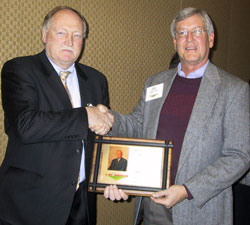 United Soybean Board CEO John Becherer (left) received the 2009 Agribusiness Leader of the Year award from the St. Louis Agribusiness Club.
United Soybean Board CEO John Becherer (left) received the 2009 Agribusiness Leader of the Year award from the St. Louis Agribusiness Club.
According to Dale Ludwig, executive director of the Missouri Soybean Merchandising Council, “John leads one of the most successful farmer-checkoff programs in the world.” Ludwig, a senior staff member of a Qualified State Soybean Board, nominated Becherer for the award. The St. Louis Agribusiness Club represents farmers and others involved in one of the richest agricultural regions of the world.
Becherer describes himself as a consensus builder and views his position at USB as an opportunity to continue his career-long interest in helping farmers farm more profitably.
“This well deserved honor reflects highly upon John’s leadership, but also to the level of commitment this organization has to U.S. soybean farmers,” says USB Chairman Phil Bradshaw, a soybean farmer from west-central Illinois. “For 15 years, John has provided guidance in leveraging checkoff dollars and complying with the federal law that established the national soybean checkoff. He helped to spearhead QUALISOY, an industry-wide effort to help market the development and availability of healthier soybeans and soy oil, and helps lead SOY 2020 to create a long-term vision for the U.S. soy industry.”
Becherer was raised on a dairy farm in central Wisconsin and has always maintained strong ties with the agricultural community. John has more than 20 years of management experience and holds a master’s degree in agricultural economics.

 When it comes to chelated trace minerals, Dr. Jim Richards with
When it comes to chelated trace minerals, Dr. Jim Richards with 
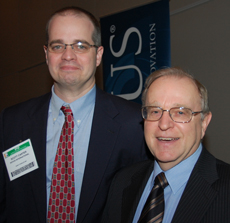 This year, it was “Historical Perspectives in Poultry Feed Management,” presented by well-known poultry science expert Dr. Steve Leeson from the University of Guelph, pictured here on the right with Dr. Scott Carter, Novus Poultry Market Manager, on the left. Dr. Leeson entertained the group with some great historical photos of poultry management through the years. According to Leeson, the commercial poultry industry as we know it pretty much started in the ’60s, as the broiler industry developed and the egg and meat industries began to diverge. Talking about feed management, he noted that producers early on were feeding poultry diets consisting of corn, soybean meal, milk, fish meal, meat meal and some raw vegetables. “They were looking for the vitamins that really hadn’t been recognized and we couldn’t buy them artificially,” he said. Milk was an especially important part of the diet to deal with health issues in flocks.
This year, it was “Historical Perspectives in Poultry Feed Management,” presented by well-known poultry science expert Dr. Steve Leeson from the University of Guelph, pictured here on the right with Dr. Scott Carter, Novus Poultry Market Manager, on the left. Dr. Leeson entertained the group with some great historical photos of poultry management through the years. According to Leeson, the commercial poultry industry as we know it pretty much started in the ’60s, as the broiler industry developed and the egg and meat industries began to diverge. Talking about feed management, he noted that producers early on were feeding poultry diets consisting of corn, soybean meal, milk, fish meal, meat meal and some raw vegetables. “They were looking for the vitamins that really hadn’t been recognized and we couldn’t buy them artificially,” he said. Milk was an especially important part of the diet to deal with health issues in flocks.  This is an interesting display in the entrance hallway to the Cattle Industry Convention.
This is an interesting display in the entrance hallway to the Cattle Industry Convention.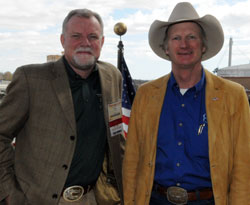 The combined meetings of the
The combined meetings of the  The 2010 International Poultry Expo/Feed Expo is getting underway here in Atlanta with associated conferences today, including the Poultry Scientific Forum, Pet Food Conference and Animal Agriculture Environmental Sustainability Summit.
The 2010 International Poultry Expo/Feed Expo is getting underway here in Atlanta with associated conferences today, including the Poultry Scientific Forum, Pet Food Conference and Animal Agriculture Environmental Sustainability Summit. 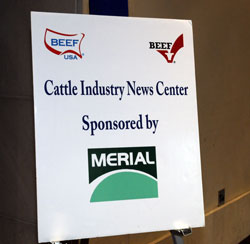 Thanks go to
Thanks go to  According to Jerry, epigenetics is the study of how you enhance DNA in crops that are already there. Currently, he noted, 75 percent of all DNA in a plant is wasted. So let’s delve deeper into how exactly epigenetics is a breakthrough for agriculture. To simplify the science, a change in the plants gene structure occurs without changing the underlying DNA. What scientists are discovering is that when these genes are changed, the “mother” will pass the gene off to her offspring. This is a big deal because the plant has the potential of an exponential yield advantage.
According to Jerry, epigenetics is the study of how you enhance DNA in crops that are already there. Currently, he noted, 75 percent of all DNA in a plant is wasted. So let’s delve deeper into how exactly epigenetics is a breakthrough for agriculture. To simplify the science, a change in the plants gene structure occurs without changing the underlying DNA. What scientists are discovering is that when these genes are changed, the “mother” will pass the gene off to her offspring. This is a big deal because the plant has the potential of an exponential yield advantage.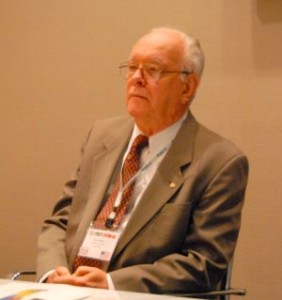 acre; and 3) they will improve the farmer’s profitability at the same time he is becoming even more sustainable in his practices.
acre; and 3) they will improve the farmer’s profitability at the same time he is becoming even more sustainable in his practices.